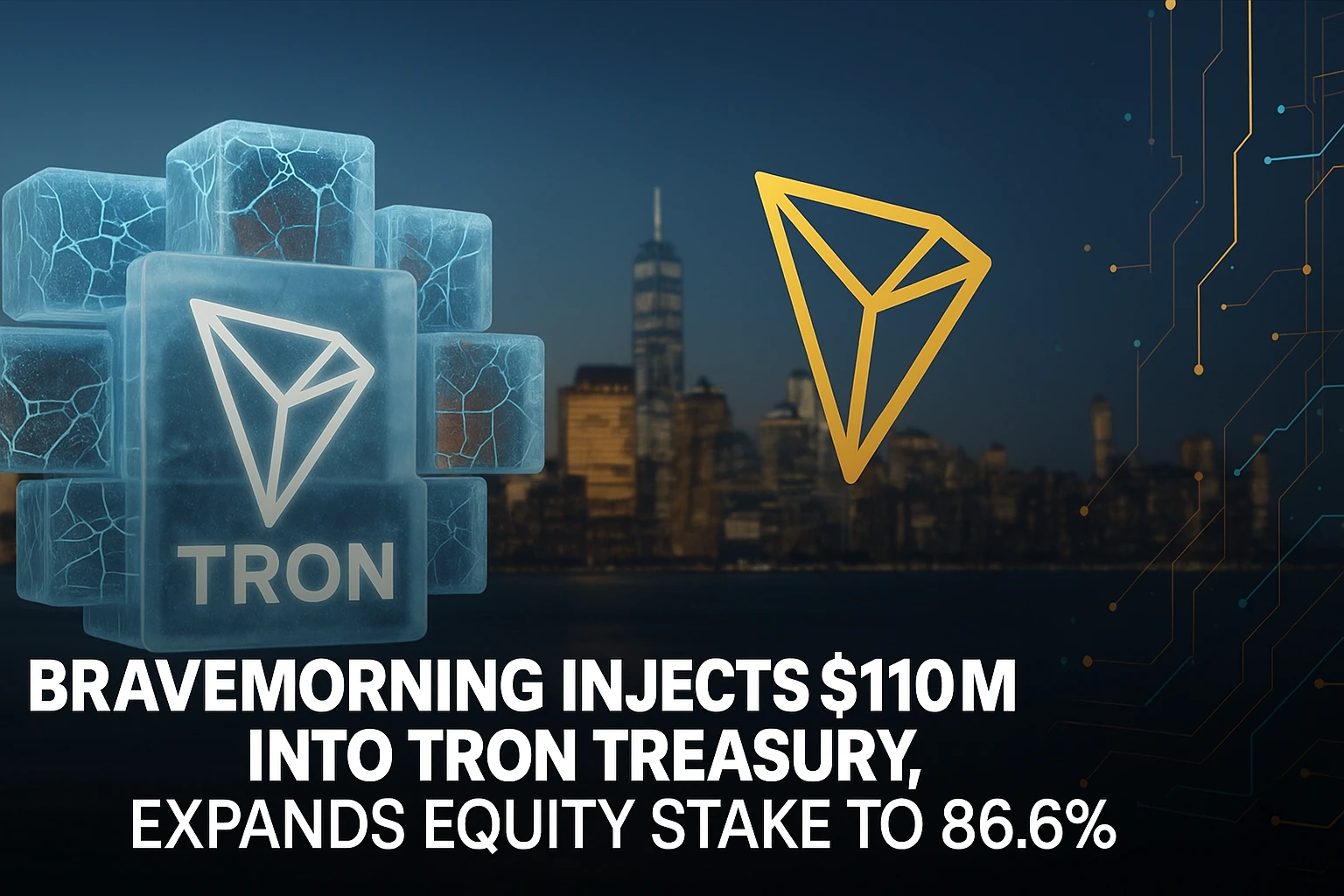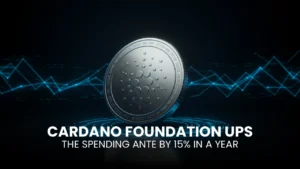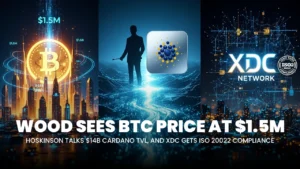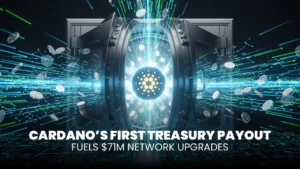Bravemorning Injects $110M Into TRON Treasury, Expands Equity Stake to 86.6%

Tron Inc. confirmed on September 2, 2025, that its largest shareholder, Bravemorning Limited, exercised warrants worth $110 million, acquiring 312.5 million TRX tokens. This move lifted Tron Inc.’s TRX treasury value to more than $220 million and increased Bravemorning’s equity stake to 86.6 % of the company.
- Market Reaction: Stock Rally Reflects Renewed Investor Confidence
- Regulatory Positioning: SEC Shelf Offering Anchors $1 Billion Ambition
- Tron’s Network Footprint: Scaling on DPoS Infrastructure
- Wallet Growth Outpaces Rivals
- Stablecoin Settlement Volumes Surpass Trillions
- DPoS at the Core of Scale
- Cost Dynamics: Fees Emerging as a Strategic Headwind
- Community and Social Media Pulse
- Governance and Concentration Risks
- Comparative Corporate Treasury Strategies in Crypto
- Long-Term Strategic Implications
- For Investors
- For Tron’s Ecosystem
- For Regulation
- Key Metrics of Tron Inc.’s Treasury Strategy
- Conclusion
- Frequently Asked Questions About TRX Treasury Strategy
- Why did Tron Inc. expand its TRX treasury by $110 million?
- How did the stock market respond?
- What role does the SEC shelf registration play?
- What are the risks of concentrated TRX holdings?
- How does Delegated Proof of Stake (DPoS) support TRX growth?
- Could Tron Inc. buy even more TRX?
- How do fees impact TRX competitiveness?
- How does this compare with other corporate treasuries?
- What does this mean for TRX holders?
- What is the long-term outlook?
- Glossary of Key Terms
This transaction brings Bravemorning’s total equity investment in Tron Inc. to $210 million, cementing its role as controlling shareholder. The expansion underscores both long-term commitment to the company and a focus on shareholder value creation.
Chief Executive Officer Rich Miller said the investment reinforced Tron Inc.’s unique position in corporate crypto finance:
“With this additional $110 million investment from our largest shareholder, Tron Inc. has strengthened its position as the largest public holder of TRX tokens. Our over $220 million treasury underscores our confidence in the Tron network and positions us to capture growth in blockchain adoption, digital payments, and Web3 infrastructure.”
The latest warrant exercise builds on the TRX Treasury Strategy that Tron Inc. launched in June 2025 through a Securities Purchase Agreement with Bravemorning. That framework combined preferred equity shares and warrants, laying the groundwork for what now amounts to $210 million in cumulative shareholder investments.
The transaction demonstrates long-term strategic alignment between Tron Inc. and its controlling shareholder. For Bravemorning, deepening exposure to TRX through treasury expansion reflects a belief in the coin’s relevance within the Delegated Proof of Stake (DPoS) architecture that secures the Tron blockchain.
Market Reaction: Stock Rally Reflects Renewed Investor Confidence
Investor sentiment was immediate. Tron Inc.’s shares jumped more than 23%, rising to $11.80 on Nasdaq, extending a rally of over 1,300% since June 2025, when the firm completed its reverse merger listing. The market capitalization now exceeds $200 million, a sharp turnaround from penny-stock status just months ago.
This rally aligns with broader investor enthusiasm for companies aligning treasury strategies with blockchain tokens. While firms like MicroStrategy placed bets on Bitcoin, Tron Inc. is doubling down on TRX, a token integral to a live payments and stablecoin network.
Regulatory Positioning: SEC Shelf Offering Anchors $1 Billion Ambition
Tron Inc.’s treasury expansion is not opportunistic speculation. It is structured through a Form S-3 shelf registration with the U.S. Securities and Exchange Commission. This filing allows the company to issue up to $1 billion worth of securities including common stock, preferred shares, warrants, and debt instruments, without repeated regulatory submissions.
This framework provides flexibility to pursue further TRX acquisitions, including a stated ambition to purchase up to 3.1 billion TRX through over-the-counter (OTC) transactions. The registration mirrors approaches used by established public companies like Coinbase and Marathon Digital, signaling that corporate crypto treasuries are becoming a regulated financial playbook.
Tron’s Network Footprint: Scaling on DPoS Infrastructure
Wallet Growth Outpaces Rivals
The Tron blockchain hosts more than 328 million active wallets, surpassing many competitors and establishing itself as one of the most used chains globally.
Stablecoin Settlement Volumes Surpass Trillions
In the first half of 2025 alone, Tron processed $3.6 trillion in stablecoin settlements, primarily in TRC-20 USDT, representing a 50 percent year-on-year increase. Nearly half of the global USDT supply now circulates on Tron.
ALSO READ: Grayscale Submits Amended S-1 For Cardano ETF To NYSE Arca As Approval Odds Hit 87%
DPoS at the Core of Scale
This growth is supported by the Tron network’s DPoS consensus model, which enables higher throughput and faster settlement times compared with Proof-of-Work chains. By entrusting transaction validation to elected nodes, DPoSensures both speed and cost efficiency at scale, making it suitable for cross-border transfers and microtransactions.
Cost Dynamics: Fees Emerging as a Strategic Headwind
Despite scale, Tron faces cost challenges. While base TRX transfers are inexpensive, TRC-20 stablecoin transfers have seen fees rise, in some cases surpassing Ethereum equivalents. This trend risks undermining Tron’s advantage as a low-cost settlement layer for remittances and micropayments.
Addressing these costs will be crucial. Although DPoS provides scalable infrastructure, governance decisions, such as fee parameter changes by Super Representatives, will determine whether Tron can maintain competitiveness in global settlements.
Community and Social Media Pulse
The announcement triggered a wave of commentary across X (formerly Twitter) and Reddit.
Financial news aggregator @CrweWorld echoed the development in real time:
https://twitter.com/CrweWorld/status/1962859961983398053
Reddit discussions echoed these themes, debating whether Tron Inc.’s control over such a large TRX treasury undermines decentralization within a DPoS model.
Governance and Concentration Risks
The expansion raises a critical question: can a company holding such a large treasury remain aligned with the spirit of Delegated Proof of Stake governance?
In a DPoS system, token holders vote for Super Representatives who validate blocks. If Tron Inc.’s treasury grows too large, it could exert disproportionate influence on network governance. Analysts warn that while consolidation provides stability for corporate strategy, it may challenge decentralization principles.
Comparative Corporate Treasury Strategies in Crypto
Tron Inc.’s move mirrors, but also diverges from, other corporate digital asset treasuries:
- MicroStrategy accumulated more than 200,000 BTC, positioning itself as a proxy for Bitcoin exposure.
- Tesla briefly held Bitcoin in its treasury before selling due to volatility concerns.
- The Ethereum Foundation manages its treasury in ETH, with a primary focus on development funding.
Tron Inc. stands out by focusing on its own token within a functioning DPoS ecosystem. This creates a hybrid corporate model that combines digital asset accumulation with real-world merchandising revenue, a strategy few of its peers have attempted.
Long-Term Strategic Implications
For Investors
Reduced circulating TRX supply may create conditions for price stability, though concentrated holdings increase risk of governance capture.
For Tron’s Ecosystem
Sustaining developer activity and user adoption will require careful balancing of treasury power against DPoS governance fairness.
For Regulation
The SEC now has a live case study in corporate digital asset treasuries tied to non-Bitcoin tokens. This may shape how future regulations address corporate engagement with blockchain networks.
ALSO READ: Tron Cuts Fees by 60% to Spur Usage, Generates $58M in August Revenues
Key Metrics of Tron Inc.’s Treasury Strategy
| Metric | Value / Detail |
| Warrant Exercise Amount | $110 million |
| TRX Added to Treasury | 312,500,100 tokens |
| Total TRX Treasury Value | Over $220 million |
| Largest Shareholder Ownership | 86.6% (Bravemorning Limited) |
| Network Scale (Wallets) | ~328 million wallets |
| USDT Settlement Volume (1H 2025) | ~$3.6 trillion (50% YoY growth) |
| SEC Shelf Offering Capacity | Up to $1 billion |
| Planned Additional TRX Purchases | Up to 3.1 billion via OTC |
Conclusion
Tron Inc.’s $110 million expansion of its TRX treasury underscores the growing role of digital asset treasuries in corporate finance. Supported by an SEC shelf registration and anchored in the efficiency of DPoS, the move propelled the company’s stock to new highs.
But governance centralization, rising fees, and regulatory scrutiny remain pressing challenges. The outcome will determine whether Tron Inc.’s treasury strategy strengthens its position as a pioneer in corporate crypto finance or exposes weaknesses in balancing corporate control with decentralized ideals.
Frequently Asked Questions About TRX Treasury Strategy
Why did Tron Inc. expand its TRX treasury by $110 million?
Its largest shareholder, Bravemorning Limited, exercised warrants to purchase 312.5 million TRX tokens, expanding Tron Inc.’s treasury and reinforcing long-term confidence in TRX.
How did the stock market respond?
Shares rose more than 23 percent to $11.80, reflecting strong investor approval. The company’s market capitalization now exceeds $200 million.
What role does the SEC shelf registration play?
It allows Tron Inc. to issue up to $1 billion in securities to fund ongoing TRX acquisitions, including OTC purchases.
What are the risks of concentrated TRX holdings?
They may undermine decentralization in a DPoS model and give Tron Inc. excessive influence over governance.
How does Delegated Proof of Stake (DPoS) support TRX growth?
DPoS enables scalability and efficiency by delegating validation to elected nodes, crucial for Tron’s massive stablecoin transaction volume.
Could Tron Inc. buy even more TRX?
Yes, the company aims to purchase up to 3.1 billion TRX through OTC transactions using proceeds from the shelf registration.
How do fees impact TRX competitiveness?
Rising fees on TRC-20 transfers may erode Tron’s advantage in micropayments and remittances unless governance adjusts costs.
How does this compare with other corporate treasuries?
Unlike MicroStrategy’s Bitcoin bet, Tron Inc. focuses on its native TRX token within a live DPoS ecosystem.
What does this mean for TRX holders?
Reduced supply could support price stability, but concentration raises governance and risk concerns.
What is the long-term outlook?
TRX’s treasury strategy represents a milestone in crypto corporate finance, but sustainability will depend on balancing corporate control with decentralized governance.
Glossary of Key Terms
- Delegated Proof of Stake (DPoS): A consensus model where token holders elect validators.
- Warrant: A financial instrument giving rights to buy securities at set prices.
- Shelf Registration (Form S-3): An SEC filing allowing delayed offerings under one registration.
- Reverse Merger: A method for private companies to go public by merging with a listed entity.
- TRX: Tron’s native blockchain token.
- TRC-20: Standard for tokens issued on the Tron blockchain.
- OTC Purchase: Over-the-counter transaction, private and off-exchange.
- Stablecoin: Token pegged to fiat currency like the U.S. dollar.
- Treasury Accumulation: Corporate strategy of building digital asset reserves.
- Validator Node: A blockchain participant responsible for confirming transactions.




